Improvement of an Equivalent Circuit Model for Li-Ion Batteries Operating at Variable Discharge Conditions
Abstract
1. Introduction
2. Battery Equivalent Circuit Model
2.1. SoC Evaluation
2.2. -SoC Characteristic
2.3. State Space Equations
3. Identification Process
Data and Identification Method
4. Model for Discharging Current Dependence
- The first step deals with the observation of the behaviour of any of the parameters influenced by the discharge current: some known trends can be found.
- Therefore, for each of the parameters, a fitting procedure is performed for identifying a suitable polynomial or exponential function; the respective coefficients are extracted, too.
- Then, an error is calculated between reference curves, and samples are extracted through the identified closed-forms.
- Lastly, an analytical expression for the battery voltage is derived thanks to the knowledge of the trend of the parameters with current.
4.1. Validation and Results
- Case 1: Comparison between optimisation algorithms. The CFSO was compared with the classical optimisation techniques, such as the genetic algorithm, GA, and the particle swarm optimisation, PSO.
- Case 2: Testing for different discharge currents. By considering the same Li-ion battery, C = 2.6 Ah, the model parameters were updated for different discharge currents, by applying the closed-form formula obtained in the previous section.
- Case 3: Trend parameters for Li-ion battery for electric vehicles. The identification process was implemented to extract the parameters trend of another battery technology, Li-ion C = 100 Ah. This confirms the trends achieved for Li-ion battery with C = 2.6 Ah.
- Case 4: Comparison between the proposed model and fixed parameters model. The discharge curves computed by our model and other models having fixed parameters but with different discharge current values were compared for demonstrating the importance of updating the parameters.
4.1.1. Case 1: Comparison between Optimisation Algorithms
4.1.2. Case 2: Test for Different Discharge Currents
4.1.3. Case 3: Trend Parameters for Li-Ion Battery for Electric Vehicles
4.1.4. Case 4: Comparison between the Proposed Model and Fixed Parameters Model
5. Conclusions
Author Contributions
Funding
Conflicts of Interest
Appendix A
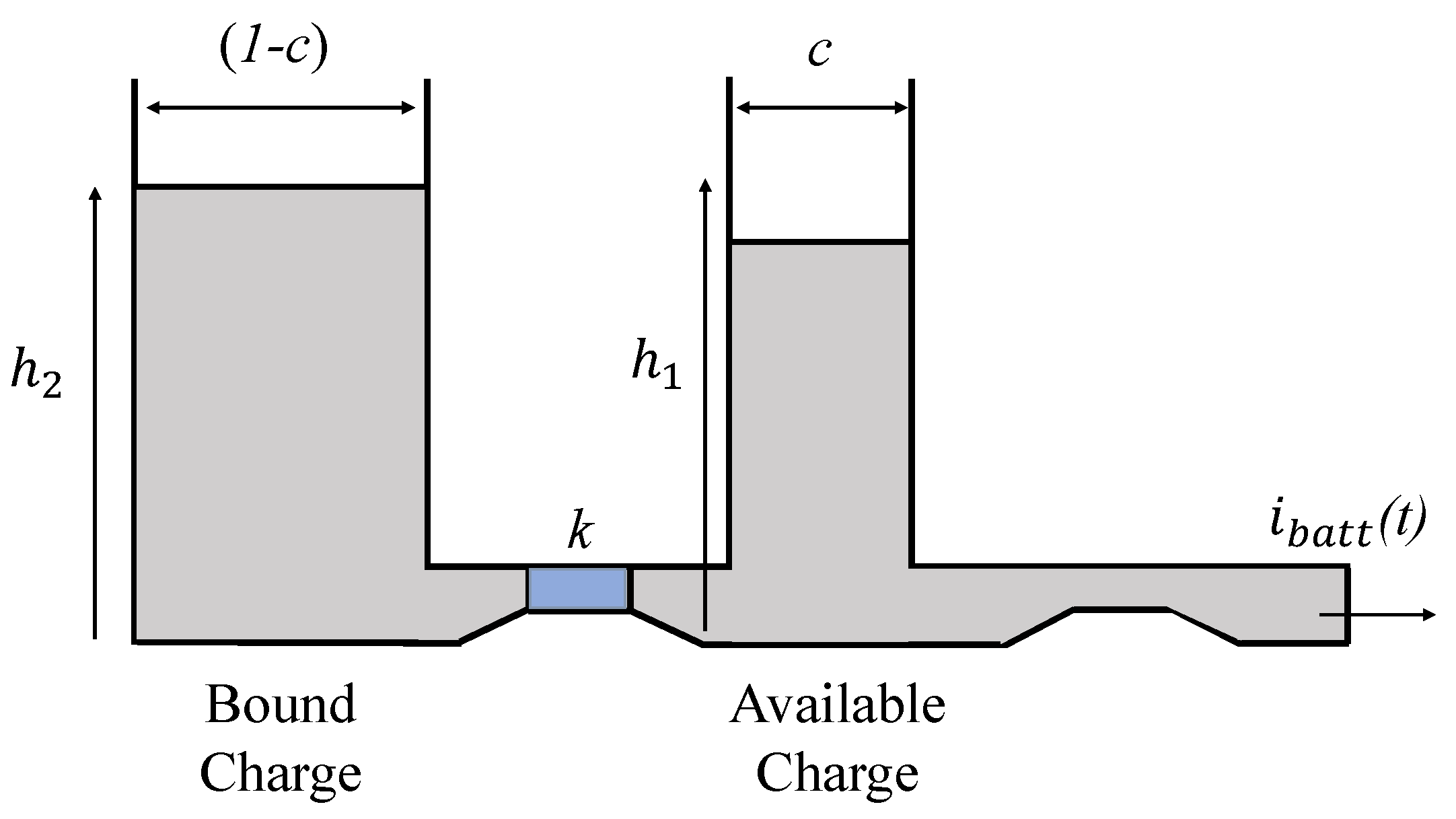
References
- Eichi, H.R.; Ojha, U.; Baronti, F.; Chow, M. Battery management system in smart grid and electric vehicles: An overview. IEEE Ind. Electron. Mag. 2013, 7, 4–16. [Google Scholar] [CrossRef]
- Luna, A.C.; Diaz, N.L.; Graells, M.; Vasquez, J.C.; Guerrero, J.M. Mixed-integer-linear-programming-based energy management system for hybrid PV-wind-battery microgrids: Modeling, design, and experimental verification. IEEE Trans. Power Electron. 2016, 32, 2769–2783. [Google Scholar] [CrossRef]
- Chao, K.H.; Lai, Y.J.; Chang, W.C. Development of a Stand-Alone Photovoltaic System Considering Shaded Effect for Energy Storage and Release. Electronics 2019, 8, 567. [Google Scholar] [CrossRef]
- Rivera-Barrera, J.; Muñoz-Galeano, N.; Sarmiento-Maldonado, H. SoC estimation for lithium-ion batteries: Review and future challenges. Electronics 2017, 6, 102. [Google Scholar] [CrossRef]
- Xu, Y.; Hu, M.; Fu, C.; Cao, K.; Su, Z.; Yang, Z. State of Charge Estimation for Lithium-Ion Batteries Based on Temperature-Dependent Second-Order RC Model. Electronics 2019, 8, 1012. [Google Scholar] [CrossRef]
- Wei, Z.; Lim, T.M.; Skyllas-Kazacos, M.; Wai, N.; Tseng, K.J. Online state of charge and model parameter co-estimation based on a novel multi-timescale estimator for vanadium redox flow battery. Appl. Energy 2016, 172, 169–179. [Google Scholar] [CrossRef]
- Astaneh, M.; Dufo-Lopez, R.; Roshandel, R.; Golzar, F.; Bernal-Agustín, J.L. A computationally efficient Li-ion electrochemical battery model for long-term analysis of stand-alone renewable energy systems. J. Energy Storage 2018, 17, 93–101. [Google Scholar] [CrossRef]
- Zhao, S.; Howey, D.A. Global sensitivity analysis of battery equivalent circuit model parameters. In Proceedings of the 2016 IEEE Vehicle Power and Propulsion Conference (VPPC), Hangzhou, China, 17–20 October 2016; pp. 1–4. [Google Scholar]
- Farmann, A.; Sauer, D.U. Comparative study of reduced order equivalent circuit models for on-board state-of-available-power prediction of lithium-ion batteries in electric vehicles. Appl. Energy 2018, 225, 1102–1122. [Google Scholar] [CrossRef]
- Zhang, C.; Allafi, W.; Dinh, Q.; Ascencio, P.; Marco, J. Online estimation of battery equivalent circuit model parameters and state of charge using decoupled least squares technique. Energy 2018, 142, 678–688. [Google Scholar] [CrossRef]
- Lucaferri, V.; Lozito, G.M.; Fulginei, F.R.; Salvini, A. A novel method for dynamic battery model identification based on CFSO. In Proceedings of the 2019 15th Conference on Ph. D Research in Microelectronics and Electronics (PRIME), Lausanne, Switzerland, 15–18 July 2019; pp. 57–60. [Google Scholar]
- Blaifi, S.; Moulahoum, S.; Colak, I.; Merrouche, W. Monitoring and enhanced dynamic modeling of battery by genetic algorithm using LabVIEW applied in photovoltaic system. Electr. Eng. 2018, 100, 1021–1038. [Google Scholar] [CrossRef]
- Hu, X.; Li, S.; Peng, H.; Sun, F. Robustness analysis of State-of-Charge estimation methods for two types of Li-ion batteries. J. Power Sour. 2012, 217, 209–219. [Google Scholar] [CrossRef]
- Rahimi-Eichi, H.; Balagopal, B.; Chow, M.Y.; Yeo, T.J. Sensitivity analysis of lithium-ion battery model to battery parameters. In Proceedings of the IECON 2013-39th Annual Conference of the IEEE Industrial Electronics Society, Vienna, Austria, 10–13 November 2013; pp. 6794–6799. [Google Scholar]
- Madani, S.S.; Schaltz, E.; Kær, S.K. A Review of Different Electric Equivalent Circuit Models and Parameter Identification Methods of Lithium-Ion Batteries. ECS Trans. 2018, 87, 23–37. [Google Scholar] [CrossRef]
- Zhang, X.; Zhang, W.; Lei, G. A review of li-ion battery equivalent circuit models. Trans. Electr. Electron. Mater. 2016, 17, 311–316. [Google Scholar] [CrossRef]
- Lozito, G.M.; Salvini, A. Swarm intelligence based approach for efficient training of regressive neural networks. Neural Comput. Appl. 2019, 31, 1–12. [Google Scholar] [CrossRef]
- EEMB Co., Ltd. Li-Ion Batteries Datasheets. Available online: https://www.ineltro.ch/media/downloads/SAAItem/45/45958/36e3e7f3-2049-4adb-a2a7-79c654d92915.pdf (accessed on 9 December 2019).
- CSB-Battery. Li-Ion Batteries Datasheets 100 Ah. Available online: http://www.csb-battery.com/upfiles/dow01341217537.pdf (accessed on 9 December 2019).

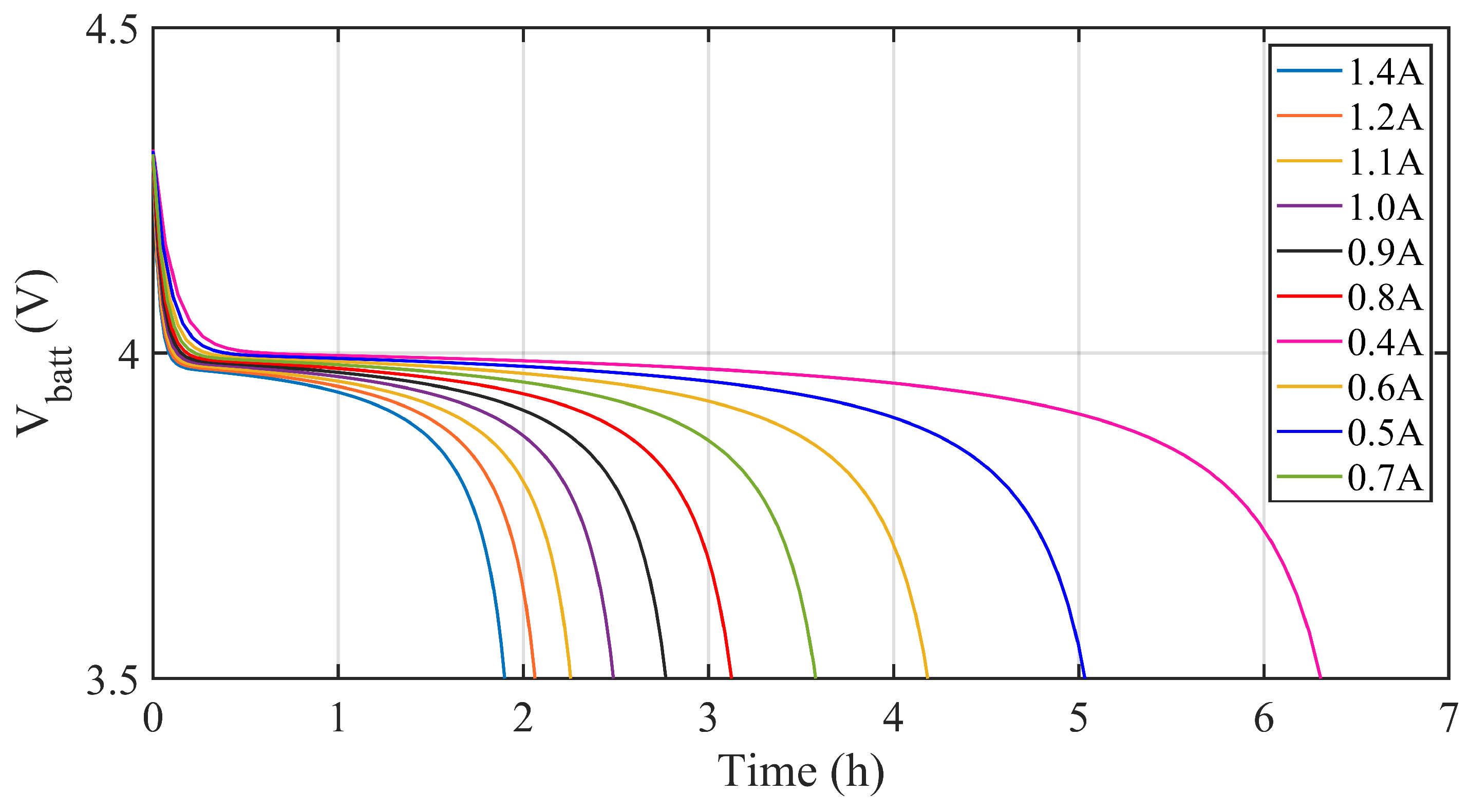
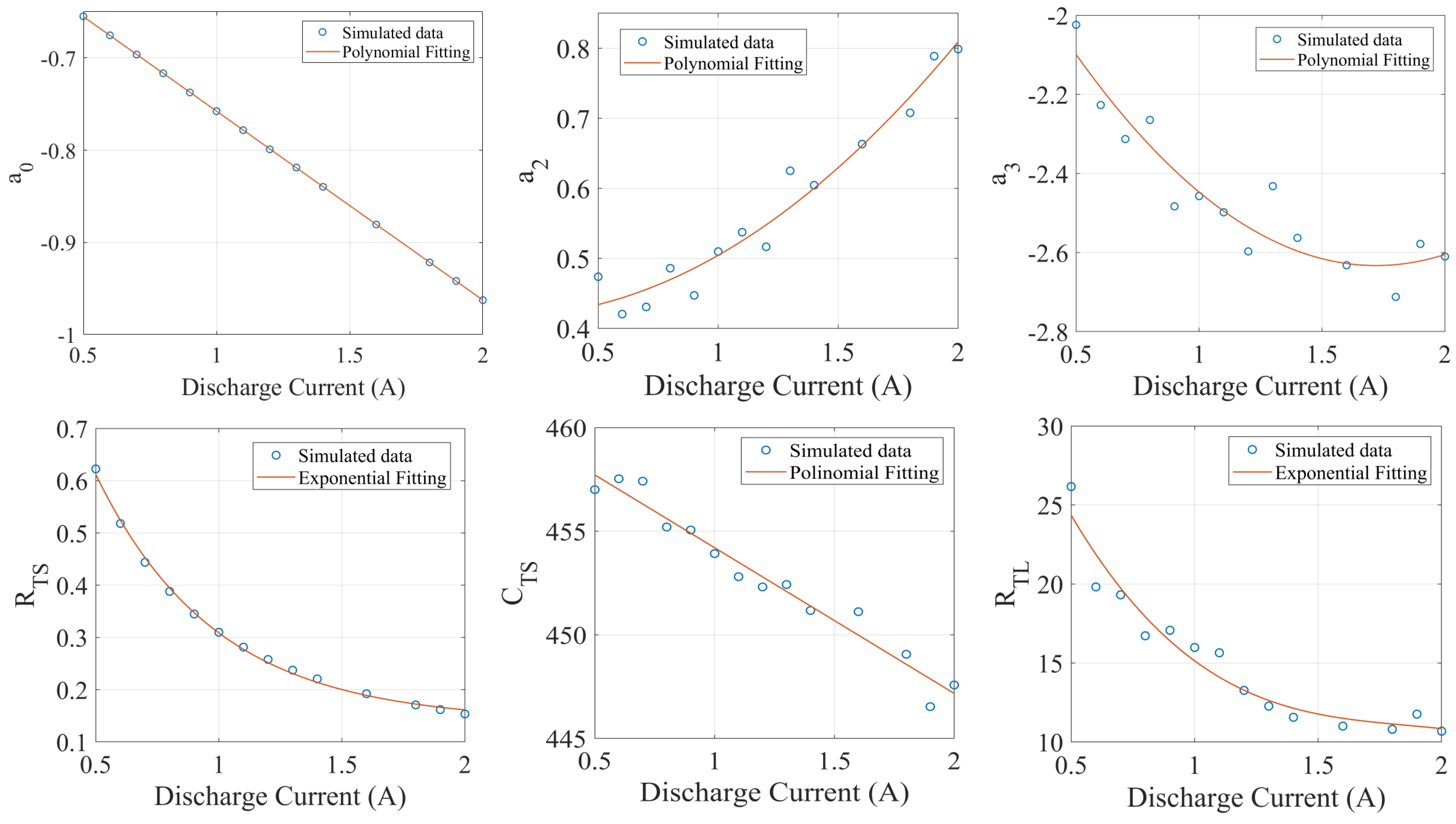
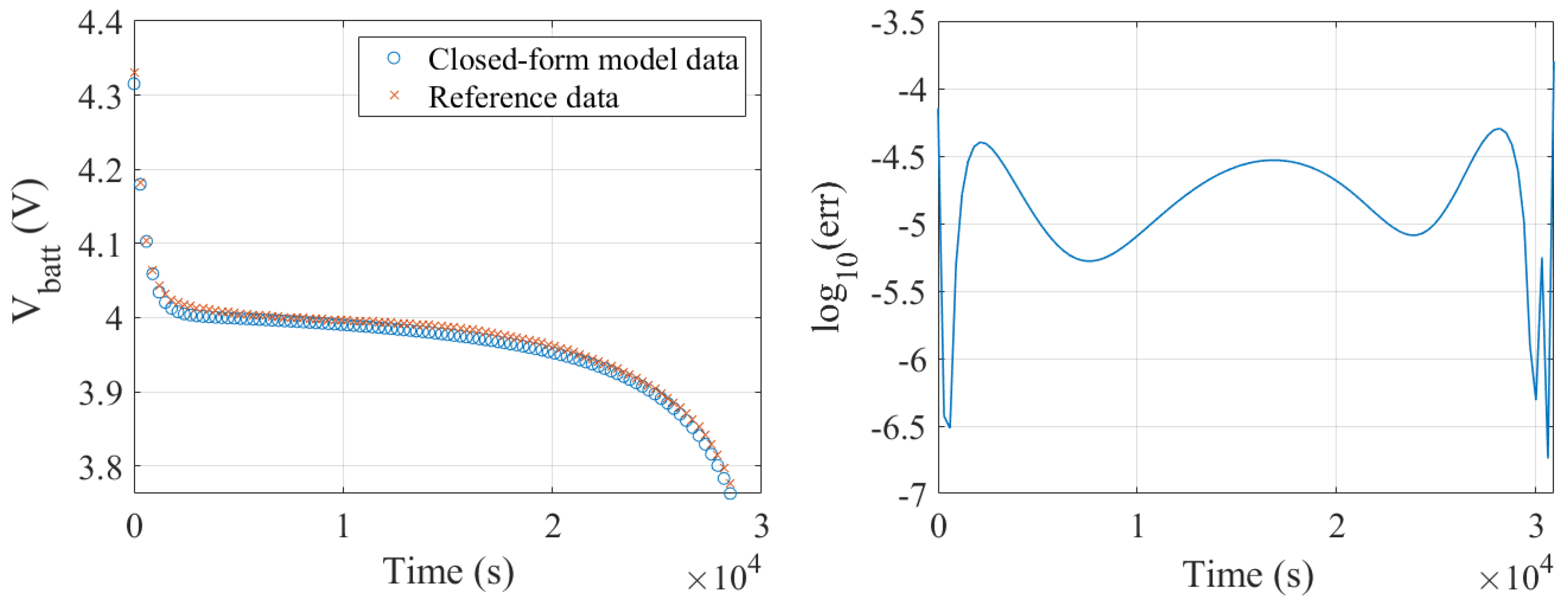
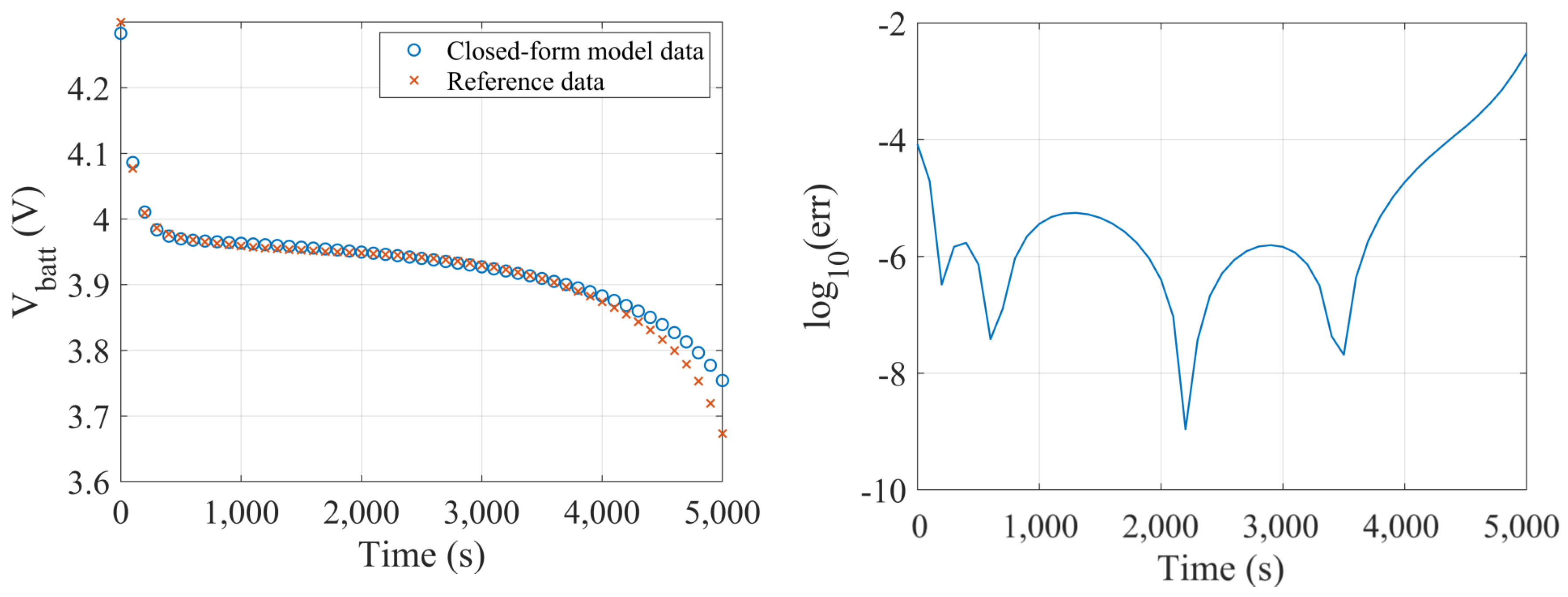

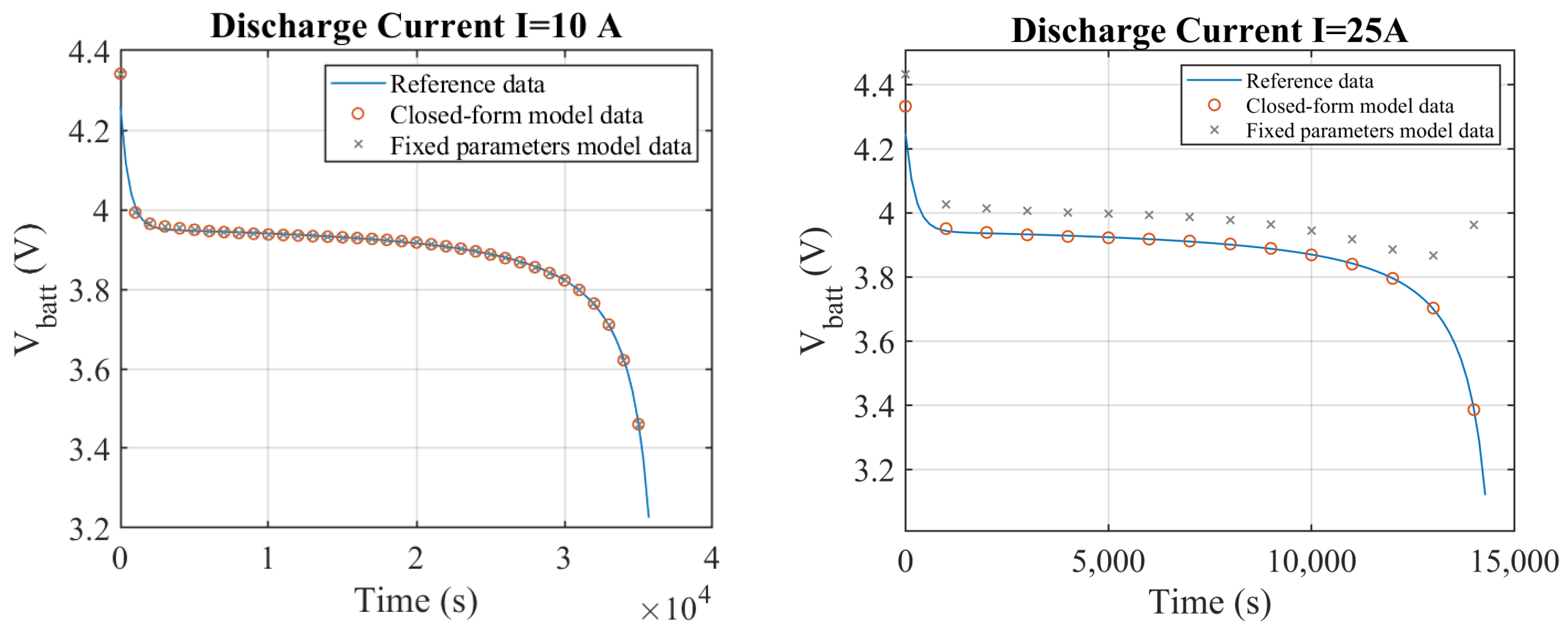
| Nominal Capacity [Ah] | 2.6 | 100 |
| Nominal Voltage [V] | 3.7 | 12 |
| Standard Discharge Current [A] | 1.27 | 43.5 |
| Maximum Discharge Current [A] | 2.6 | 500 |
| Operating temperature Discharge [°C] | −20 −60 | −15 −50 |
| Internal Impedance [mΩ] | ≤70 | 8 |
| Parameters | 0.5 A | 1.3 A | 1.9 A | |
|---|---|---|---|---|
| −6.350 × 10−1 | −7.99010 × 10−1 | −9.62010 × 10−1 | ||
| 2.685 × 101 | 2.634 × 101 | 2.630 × 101 | ||
| 3.146 × 10−1 | 5.160 × 10−1 | 7.890 × 10−1 | ||
| −2.024 × 100 | −2.597 × 100 | −2.612 × 100 | ||
| −1.269 × 100 | −3.505 × 100 | −3.419 × 100 | ||
| 7.205 × 100 | 9.898 × 100 | 9.518 × 100 | ||
| [Ω] | 3.805 × 10−4 | 3.768 × 10−4 | 3.246 × 10−4 | |
| [Ω] | 7.810 × 10−1 | 2.572 × 10−1 | 1.543 × 10−1 | |
| [F] | 4.616 × 102 | 4.523 × 102 | 4.476 × 102 | |
| [Ω] | 1.551 × 101 | 1.326 × 101 | 1.068 × 101 | |
| [F] | 2.141 × 103 | 1.265 × 103 | 1.431 × 103 |
| Linear | ||||||
| −5.527 × 10−1 | 4.612 × 102 | |||||
| −2.049 × 10−1 | −7.032 × 100 | |||||
| 2 thorder polynomial | ||||||
| 4.184 × 10−1 | −1.572 × 100 | 3.635 × 101 | ||||
| −2.340 × 10−2 | −1.233 × 100 | −2.933 × 101 | ||||
| 1.094 × 10−1 | 3.584 × 10−1 | 8.425 × 100 | ||||
| Exponential | ||||||
| 1.319 × 100 | ||||||
| 2.056 × 100 | ||||||
| 1.399 × 10−1 | ||||||
| 0.9997 | 0.9557 | 0.8429 | 0.9986 | 0.9582 | 0.9396 |
| CFSO + LM | PSO + LM | GA + LM | |
|---|---|---|---|
| Iterations | 250 | 250 | 250 |
| RMSE | 0.0447 | 0.0801 | 0.0503 |
| Computational time [s] | 1.45 | 1.21 | 2.69 |
| Discharge Current [A] | MSE | |||
|---|---|---|---|---|
| 6.2 × 10−3 | ||||
| 8.3 × 10−3 | ||||
| 2.1 × 10−2 | ||||
| 3.3 × 10−2 |
© 2020 by the authors. Licensee MDPI, Basel, Switzerland. This article is an open access article distributed under the terms and conditions of the Creative Commons Attribution (CC BY) license (http://creativecommons.org/licenses/by/4.0/).
Share and Cite
Lozito, G.M.; Lucaferri, V.; Riganti Fulginei, F.; Salvini, A. Improvement of an Equivalent Circuit Model for Li-Ion Batteries Operating at Variable Discharge Conditions. Electronics 2020, 9, 78. https://doi.org/10.3390/electronics9010078
Lozito GM, Lucaferri V, Riganti Fulginei F, Salvini A. Improvement of an Equivalent Circuit Model for Li-Ion Batteries Operating at Variable Discharge Conditions. Electronics. 2020; 9(1):78. https://doi.org/10.3390/electronics9010078
Chicago/Turabian StyleLozito, Gabriele Maria, Valentina Lucaferri, Francesco Riganti Fulginei, and Alessandro Salvini. 2020. "Improvement of an Equivalent Circuit Model for Li-Ion Batteries Operating at Variable Discharge Conditions" Electronics 9, no. 1: 78. https://doi.org/10.3390/electronics9010078
APA StyleLozito, G. M., Lucaferri, V., Riganti Fulginei, F., & Salvini, A. (2020). Improvement of an Equivalent Circuit Model for Li-Ion Batteries Operating at Variable Discharge Conditions. Electronics, 9(1), 78. https://doi.org/10.3390/electronics9010078






